I Peaked in Preschool but at Least I Have Something to be Proud Of: Final Book
It has been a long and arduous journey, but my book is finally complete.
Something Dr. Churchill said at the beginning of the semester that really resonated with me was “learn to fail or fail to learn.” Ultimately, that became the theme of my booklet-making process. I can be a perfectionist when it comes to creative projects, which is typically immobilizing for me. I get so scared of creating an unimpressive piece that I refrain from actually trying to make something good at all. I was worried that I would fall victim to my all-or-nothing mentality with the book project and either fail to produce anything of note due to procrastination or spend countless hours meticulously putting it all together.
With that fear in mind, I set out to make a tongue-in-cheek book about how I think I peaked in Preschool and it’s all been down hill from there. I struggled to come up with enough material–so maybe I haven’t peaked yet. I spent a lot of time staring at my materials and feeling like I would never come up with anything interesting enough to become an entire book. So, I leaned into my desire to procrastinate and put off the task of coming up with a topic by writing a book about procrastination. I ended up with I Peaked in Preschool: A Procrastination A-Z Book.
I decided to go with this method because I know more about procrastination than almost any other topic and I thought it would be more fun to write a silly little book about all the different ways I procrastinate. In the end, I enjoyed the creative process of making this book so much (despite its seemingly endless stream of difficulties) that I used it to procrastinate on other work.
My first prototype was awful, by my own standards. I hadn’t fully fleshed out any ideas before I started putting it together so it was very sloppy and I ended up only making a couple of pages, just as I had expected.


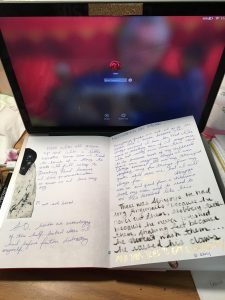
My first prototype was called AHHH! The Niara Webb Story and it was rough. I hand-wrote everything and, because I couldn’t find pens in all of the colors I wanted, I ended up using a combination of a ballpoint pen, an eyeliner pen, and a fabric marker. I cut out family pictures and pasted them in. Overall, it is clear that I had not fully articulated my vision for the book to myself and therefore could not efficiently translate my ideas onto the page. Nothing from this prototype made it to the final product.
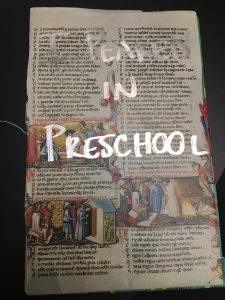

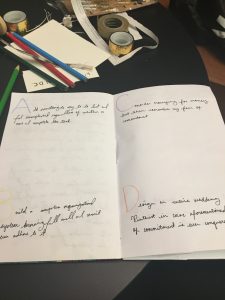
By the time I finished my second prototype, I finally had a clear idea of what I wanted to do. Since it became clear to me that I would not think that any of the ideas I came up with were good enough to print, I decided to go with the anti-idea and write about procrastination. They say that good writers write what they know and, unfortunately, procrastination and I are very well acquainted.
My goals for this version were to come up with a complete A-Z list of procrastination activities I enjoy and to at least plot them all out in my book, even if I did not have time for illustrations.
Many of my A-Z ideas did not even make it to the third prototype either because I could not come up with illustrations for them or I thought of something more specific to my experiences than simply “watch Netflix.” However, the one aesthetic quality that I maintained from prototype 2 until my final product was the use of collage by cutting out words, ads, and cartoons from magazines. Here, I simply used an article from The New Yorker as my cover, but in later prototypes I incorporated collage throughout the book.
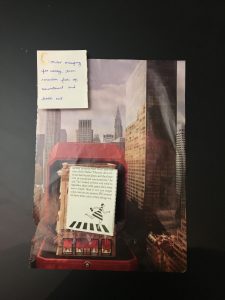
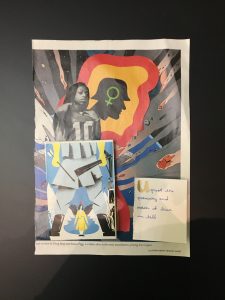
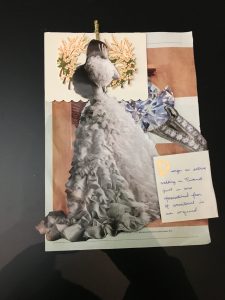
Prototype 3 was when I realized how long it would take me to actually finish this project. I finally knew what I wanted to write on each page and the aesthetic I hoped would unify my pages and it required a lot of work. My collages take on a scrapbooking quality on some pages, like the one featured on the above right, which includes an actual mini-clothespin.
I was very happy to be finally making pop-ups and perfecting each page, but the process was incredibly tedious: making sure everything was aligned, measuring out tape, ensuring each page was engaging but not cluttered. I only finished three pages for this prototype but was relieved to feel like I was finally on the right track.
Finally, after spending the greater part of my weekend poring over each page, I have my final book.


This book finally fulfilled my expectations for my aesthetic standards and content quality. Overall, I learned that there are always more improvements to be made on any project, so it’s best to be proud of development more than the final product. Of course, there are many aspects that I would like to change, for instance the binding is very delicate. However, the final product is much more advanced than the first prototype and that is something to be proud of. I have realized that I would continue to fail to meet my own expectations unless I focused on small improvements over the big picture. Sure, I don’t think my book is worthy of any awards, but I developed a clear collage aesthetic and finished the book even when I thought I couldn’t. If I hadn’t accepted that I would not always meet my goals, I never would have finished this project.Learning to fail is better than not learning anything at all.